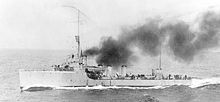This article needs additional citations for verification .(July 2017) |
 |
| Ships of the Swedish Navy |
| Capital ships |
| Coastal defence ships |
| Corvettes |
| Cruisers |
| Destroyers |
| Frigates |
| Mine warfare vessels |
| Monitors |
| Patrol vessels |
| Gunboats |
| Sloops of war |
| Submarines |
| Torpedo boats |
This is a list of Swedish destroyers commissioned between 1902 and 1959. The Swedish Navy has once re-numbered all its destroyers. Some ships were assigned hull numbers, which were later changed. Other ships have generally been issued a number, but never wore it. Some destroyers of the Göteborg and Visby classes were rebuilt between 1966–68 and were reclassified as frigates, changing their hull numbers from J to F. No ship has ever had the hull number J15.




